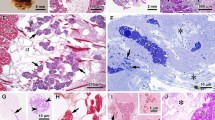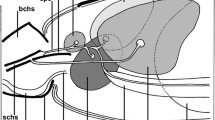Summary
Pomatoceros caeruleus possesses a pair of simple acinar calcium-secreting glands lying in the ventral peristomium. Each gland has a single large secretory acinus containing columnar secretory cells with basal nuclei. Golgi complexes and flattened cisternae of the rough endoplasmic reticulum are abundant in the midregion and secretory vacuoles fill the apical cytoplasm. Elongate microvilli extend from the apices of the cells into the gland lumen. An organelle-free zone, the intracellular channel, extends from near the base almost to the apex of the cells. It is bordered on one side by the lateral cell membranes and is separated from the organelle compartment by elongate profiles of the rough endoplasmic reticulum.
The secretory products of the calcium-secreting glands have the form of cubic or rhombohedral granules with average dimensions of 150–200 mμ on a side. The granules are composed of a fibrous organic matrix in which needle-like calcite crystals are deposited. The possible mode of synthesis of the calcified secretory granules is discussed.
Similar content being viewed by others
References
Bannasch, P.: Hüllenlose Cytoplasmainclusionen und ihre Beziehung zur Sekretbildung im exokrinen Pankreas der Maus. J. Ultrastruct. Res. 15, 528–542 (1966).
Borle, A. B.: Membrane transfer of calcium. Clin. Orthop. Rel. Res. 52, 267–291 (1967).
Crane, R. K.: Structural and functional organization of an epithelial cell brush border. In: Intracellular transport (C. B. Warren, ed.). Symp. Internat. Soc. Cell. Biol. 5, 71–102 (1967).
De Duve, C., Wattiaux, R.: Functions of lysosomes. Ann. Rev. Physiol. 28, 485–492 (1966).
Ericsson, J. L. E., Trump, B. F., Weibel, J.: Electron microscopic studies of the proximal tubule of the rat kidney. II. Cyto-segresomes and cytosomes: their relationship to each other and the lysosome concept. Lab. Invest. 14, 1341–1365 (1965).
Erlandson, R. A.: A new Maraglas, D.E.R. 732 emebdment for electron microscopy. J. Cell Biol. 22, 704–709 (1964).
Friend, D. S.: Cytochemical staining of multivesicular body and Golgi vesicles. J. Cell Biol. 41, 269–279 (1969).
Halstead, L. B.: Are mitochondria directly involved in biological mineralization ? The mitochondrion and the origin of bone. Calc. Tiss. Res. 3, 103–104 (1969).
Hedley, R. H.: Studies on serpulid tube formation. I. The secretion of the calcareous and organic components of the tube by Pomatoceros triqueter. Quart. J. micro. Sci. 97, 411–419 (1956a).
—: Studies on serpulid tube formation. II. The calcium-secreting glands in the peristomium of Spirorbis, Hydroides, and Serpula. Quart. J. micr. Sci. 97, 421–427 (1956b).
Helander, H. F.: Morphology of animal secretory gland cells. In: Organisation der Zelle. II. Sekretion und Exkretion, p. 2–21. Berlin-Heidelberg-New York: Springer 1965.
Holtzman, E., Dominitz, R.: Cytochemical studies of lysosomes, Golgi apparatus and endoplasmic reticulum in secretion and protein uptake by adrenal medulla cells of the rat. J. Histochem. Cytochem. 16, 320–336 (1968).
Jamieson, J. D., Palade, G. E.: Intracellular transport of secretory proteins in the pancreatic exocrine cell. I. Role of the peripheral elements of the Golgi complex. J. Cell Biol. 34, 577–596 (1967a).
—: Intracellular transport of secretory proteins in the pancreatic exocrine cell. II. Transport to condensing vacuoles and zymogen granules. J. Cell Biol. 34, 597–615 (1967b).
Luft, J. H.: Improvements in epoxy resin embedding methods. J. biophys. biochem. Cytol. 9, 409–414 (1961).
McGee-Russell, S. M.: The method of combined observations with light and electron microscopes applied to the study of histochemical colourations in nerve cells and oocytes. In: Cell structure and its interpretation (S. M. McGee-Russell and K. A. Ross, eds.), pp. 183–207. London: Edward Arnold (Publishers) Ltd. 1968.
McNabb, J. D., Sandburn, E.: Filaments in the microvillus border of intestinal cells. J. Cell Biol. 22, 701–704 (1964).
Meek, G. A., Bradbury, S.: Localization of thiamine pyrophosphatase activity in the Golgi apparatus of a mollusc Helix aspersa. J. Cell Biol. 18, 73–85 (1963).
Millonig, G. A.: A modified procedure for lead staining of thin sections. J. biophys. biochem. Cytol. 11, 736–739 (1961).
Neff, J. M.: Calcium carbonate tube formation by serpulid polychaete worms: Physiology and ultrastructure. Ph. D. Thesis, Duke University, 305 pp. 1967.
—: Mineral regeneration by serpulid polychaete worms. Biol. Bull. 136, 76–90 (1969).
Neutra, M., Leblond, C. P.: Radioautographic comparison of the uptake of galactose-H3 and glucose-H3 in the Golgi region of various cells secreting glycoproteins or mucopolysaccharides. J. Cell Biol. 30, 137–150 (1966).
Novikoff, A. B., Essner, B. E., Quintana, N.: Golgi apparatus and lysosomes. Fed. Proc. 23, 1010–1022 (1964).
Rambourg, A., Hernandez, W., Leblond, C. P.: Detection of complex carbohydrates in the Golgi apparatus of rat cells. J. Cell Biol. 40, 395–414 (1969).
Revel, J. P., Hay, E. D.: An autoradiographic and electron microscopic study of collagen synthesis in differentiating cartilage. Z. Zellforsch. 61, 110–144 (1963).
Reynolds, E. S.: The use of lead citrate at high pH as an electron-opaque stain in electron microscopy. J. Cell Biol. 17, 208–212 (1963).
Rohr, H. von, Walter, S.: Die Mucopolysaccharide-Synthese in ihrer Beziehung zur submikroskopischen Struktur der Knorpelzelle. Acta anat. (Basel) 64, 223–234 (1966).
Smith, R. E., Farquar, M. G.: Lysosome function in the regulation of the secretory process in cells of the anterior pituitary gland. J. Cell Biol. 31, 319–347 (1966).
Soulier, A.: Études sur quelques points de l'anatomie des annelides tubicoles de la région de Cette. Organes sécrétéurs du tube et appareil digestif. Trav. Inst. Zool. Montpellier et Stat Marit. Cette. Ser 2 (2), 310 pp. (1891).
Strauss, W.: Lysosomes, phagosomes and related particles. In: Enzyme cytology (D. B. Roodyn, ed.), pp. 239–319. New York: Academic Press 1967.
Talmage, R. V.: Calcium homeostasis — calcium transport — parathyroid action. The effects of parathyroid hormone on the movement of calcium between bone and fluid. Clin. Orthop. Rel. Res. 67, 210–224 (1969).
Thomas, J. G.: Pomatoceros, Sabella, and Amphitrite. Liverpool Mar. Biol. Comm. Mem. (33) 44 pp. (1940).
Tigyi, A., Montsko, T., Komaromy, L., Lissak, K.: Comparative ultrastructural analysis of the mechanism of secretion. Acta physiol. Acad. Sci. hung. 33, 127–140 (1968).
Travis, D. F.: The structure and organization of and the relationship between, the inorganic crystals and the organic matrix of the prismatic region of Mytilus edulis. J. Ultrstruct. Res. 23, 183–215 (1968).
Vovelle, J.: Processus glandulaires impliqués dans la réconstitution du tuhe chez Pomatoceros triqueter (L.) Annelide Polychaete (Serpulidae). Bull. Lab. Marit. Dinard. (42), 10–32 (1956).
Watabe, N.: Studies on shell formation XI. Crystal matrix relationships in the inner layers of mollusc shells. J. Ultrastruct. Res. 12, 351–370 (1965).
Author information
Authors and Affiliations
Additional information
Part of this work represents a portion of a thesis submitted in partial fulfillment of the requirements for the degree of Doctor of Philosophy at Duke University. I wish to express my thanks to Dr. Karl M. Wilbur and Dr. Norimitsu Watabe for their advice and encouragement during this study. This study was supported by Public Health Service Grants 5TI DE 92-05 and DE 02668 from the National Institutes of Health.
Rights and permissions
About this article
Cite this article
Neff, J.M. Ultrastructural studies of the secretion of calcium carbonate by the serpulid polychaete worm, Pomatoceros caeruleus . Z. Zellforsch. 120, 160–186 (1971). https://doi.org/10.1007/BF00335534
Received:
Issue Date:
DOI: https://doi.org/10.1007/BF00335534




